1998 CADILLAC SEVILLE load capacity
[x] Cancel search: load capacityPage 226 of 378
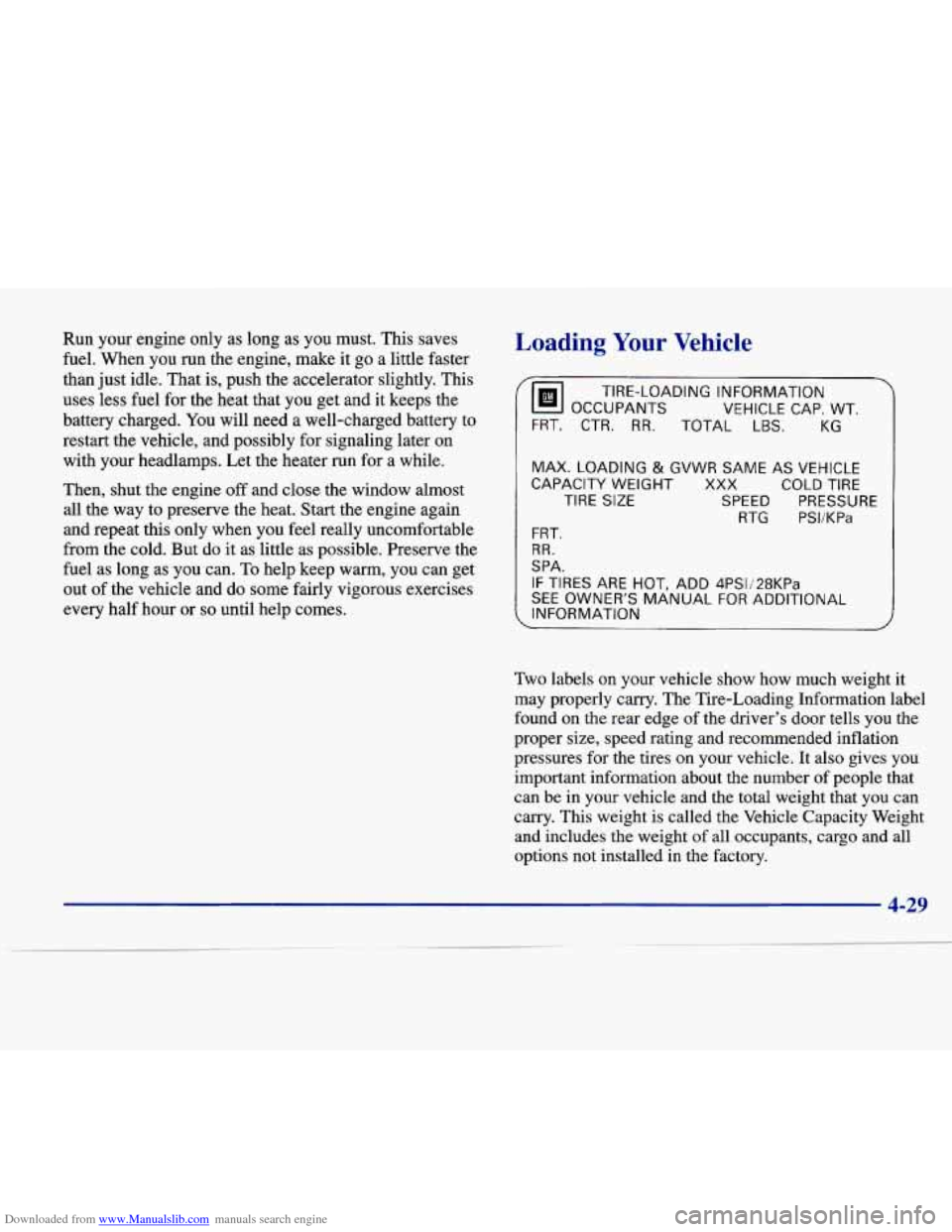
Downloaded from www.Manualslib.com manuals search engine Run your engine only as long as you must. This saves
fuel. When you run the engine, make it go a little faster
than just idle. That
is, push the accelerator slightly. This
uses less fuel for the heat that you get and it keeps the
battery charged.
You will need a well-charged battery to
restart the vehicle, and possibly for signaling later on
with your headlamps. Let the heater run for a while.
Then, shut the engine
off and close the window almost
all the way to preserve the heat. Start the engine again
and repeat this only when you feel really uncomfortable
from the cold.
But do it as little as possible. Preserve the
fuel as long as you can. To help keep warm, you can get
out
of the vehicle and do some fairly vigorous exercises
every half hour or
so until help comes.
Loading Your Vehicle
TIRE-LOADING INFORMATION
VEHICLE CAP. WT.
FRT. CTR. RR. TOTAL LBS.
MAX. LOADING
& GVWR SAME AS VEHICLE
CAPACITY WEIGHT XXX
COLD TIRE
TIRE SIZE SPEED PRESSURE
RTG PSI/KPa
FRT.
RR.
SPA.
IF TIRES ARE HOT, ADD 4PS1/28KPa
SEE OWNER’S MANUAL FOR ADDITIONAL
may properly carry. The Tire-Loading Information label
found on the rear edge
of the driver’s door tells you the
proper size, speed rating and recommended inflation
pressures for the tires on your vehicle. It also gives you
important information about the number of people that
can be in your vehicle and the total weight that you can
carry. This weight is called the Vehicle Capacity Weight
and includes the weight
of all occupants, cargo and all
options not installed in the factory.
4-29
Page 227 of 378
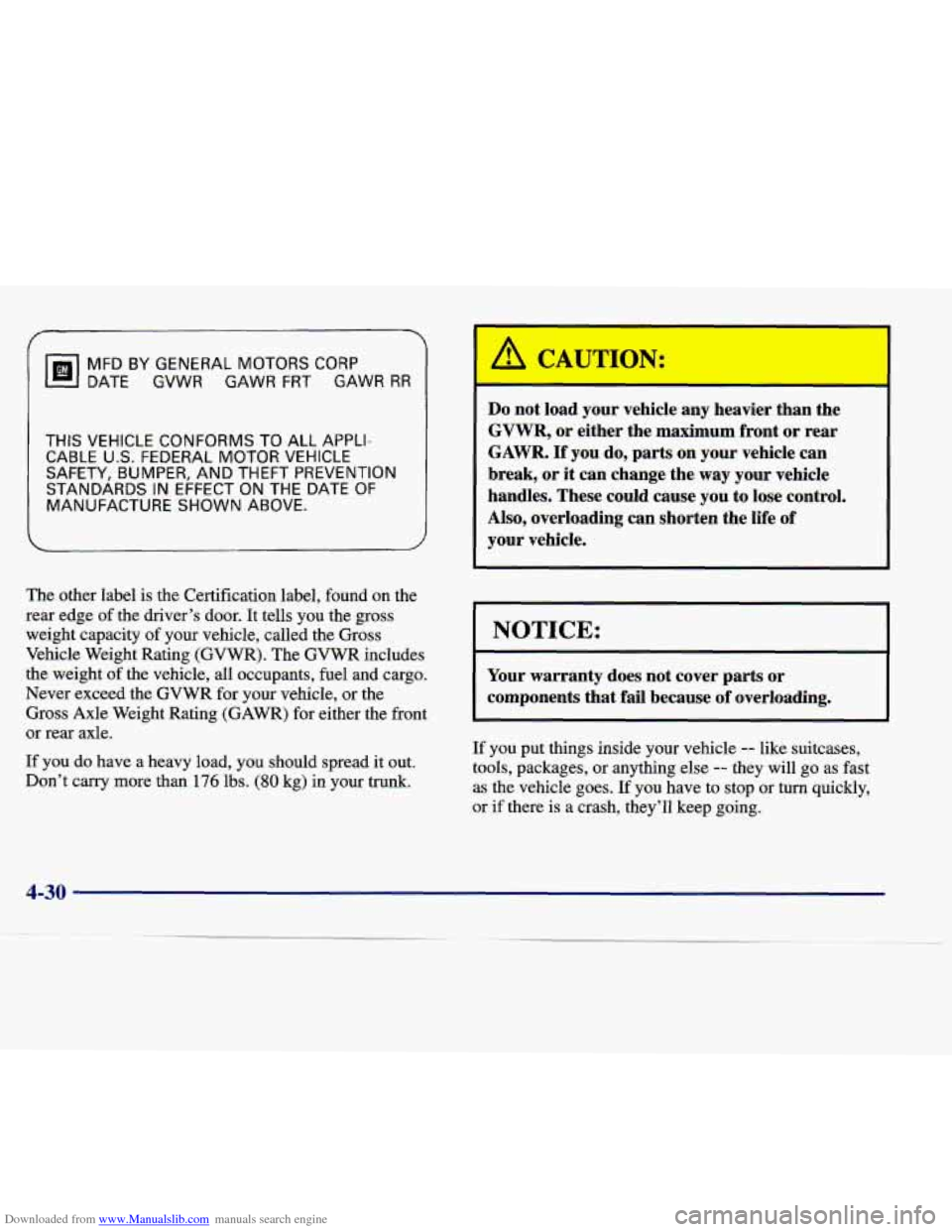
Downloaded from www.Manualslib.com manuals search engine /-
MFDBYGENERALMOTORSCORP DATE GVWR
GAWR FRT GAWR RR
THIS VEHICLE CONFORMS TO ALL APPLI-
CABLE
U.S. FEDERAL MOTOR VEHICLE
SAFETY,
BUMPER, AND THEFT PREVENTION
STANDARDS
IN EFFECT ON THE DATE OF
MANUFACTURE SHOWN ABOVE.
:
The other label is the Certification label, found on the
rear edge of
the driver’s door. It tells you the gross
weight capacity of your vehicle, called the Gross
Vehicle Weight Rating
(GVWR). The GVWR includes
the weight of the vehicle, all occupants, fuel and cargo.
Never exceed the GVWR for your vehicle, or the
Gross Axle Weight Rating (GAWR) for either the front
or rear axle.
If you do have a heavy load, you should spread
it out.
Don’t carry more than
176 lbs. (80 kg) in your trunk.
Do not load your vehicle any heavier than the
GVWR, or either the maximum front or rear
GAWR.
If you do, parts on your vehicle can
break, or it can change the
way your vehicle
handles. These could cause you to lose control.
Also, overloading can shorten the life
of
your vehicle.
NOTICE:
Your warranty does not cover parts or
components that fail because
of overloading.
If you put things inside your vehicle -- like suitcases,
tools, packages, or anything else
-- they will go as fast
as the vehicle goes.
If you have to stop or turn quickly,
or
if there is a crash, they’ll keep going.
4-30
Page 228 of 378

Downloaded from www.Manualslib.com manuals search engine 1 A CAUTION:
Things you put inside your vehicle can strike
and injure people in a sudden stop or turn,
or
in a crash.
Put things in the trunk of your vehicle. In a
trunk, put them as
far forward as you can.
Try to spread the weight evenly.
inside the vehicle
so that some of them are
above the tops of the seats.
Don’t leave an unsecured child restraint in
your vehicle.
When you carry something inside the
vehicle, secure it whenever
you can.
Never stack heavier things, like suitcases,
Electronic Level Control
This feature keeps the rear of your vehicle level as
the load changes. It’s automatic
-- you don’t need to
adjust anything.
Towing a Trailer
A CAUTION:
If you don’t use the correct equipment and drive
properly, you can lose control when you pull a
trailer. For example, if the trailer is too heavy,
the brakes may not work well
-- or even at all.
You and your passengers could be seriously
injured. You may also damage your vehicle; the
resulting repairs would not be covered by your
warranty. Pull
a trailer only if you have followed
all the steps in this section. Ask your dealer for
advice and information about towing a trailer
with your vehicle.
Your vehicle can tow a trailer if it is equipped with the
proper trailer towing equipment.
To identify what the
vehicle trailering capacity
is for your vehicle, you
should read the information in “Weight of the Trailer”
that appears later in this section. But trailering is
different than just driving your vehicle
by itself.
4-31
~~
Page 230 of 378
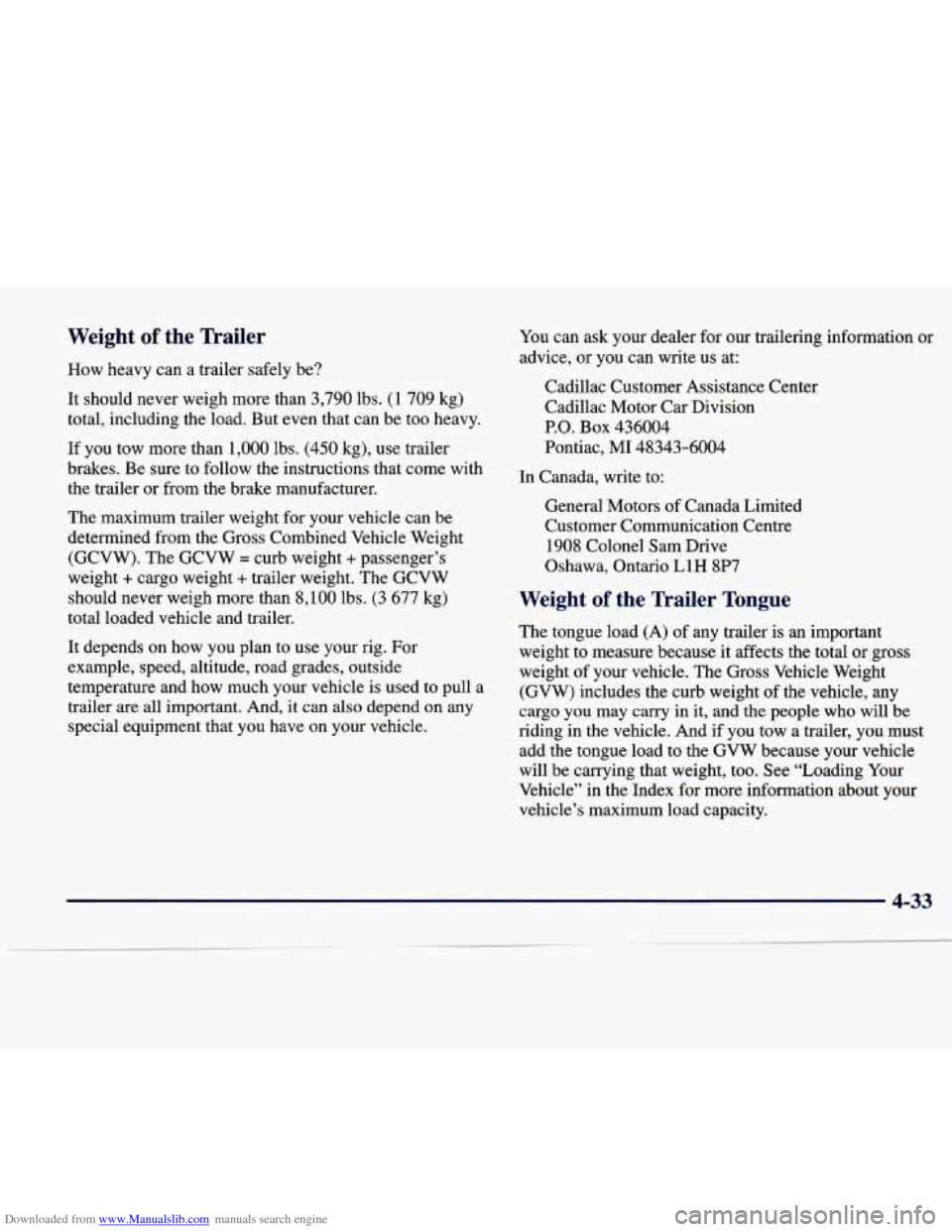
Downloaded from www.Manualslib.com manuals search engine Weight of the Trailer
How heavy can a trailer safely be?
It should never weigh more than 3,790 lbs. (1 709 kg)
total, including the load. But even that can be too heavy.
If you tow more than 1,000 lbs. (450 kg), use trailer
brakes. Be sure to follow the instructions that come with
the trailer or from the brake manufacturer.
The maximum trailer weight for your vehicle can be
determined from the Gross Combined Vehicle Weight
(GCVW). The GCVW
= curb weight + passenger’s
weight
+ cargo weight + trailer weight. The GCVW
should never weigh more than
8,100 lbs. (3 677 kg)
total loaded vehicle and trailer.
It depends on how you plan to use your rig. For
example, speed, altitude, road grades, outside
temperature and how much your vehicle is used to pull a
trailer are
all important. And, it can also depend on any
special equipment that you have
on your vehicle. You
can ask your dealer for our trailering information or
advice, or
you can write us at:
Cadillac Customer Assistance Center
Cadillac Motor Car Division
P.O. Box 436004
Pontiac,
MI 48343-6004
In Canada, write to:
General Motors
of Canada Limited
Customer Communication Centre
1908 Colonel Sam Drive
Oshawa, Ontario LlH 8P7
Weight of the Trailer Tongue
The tongue load (A) of any trailer is an important
weight to measure because it affects the total
or gross
weight of your vehicle. The Gross Vehicle Weight
(GVW) includes the curb weight of the vehicle, any
cargo you may carry in
it, and the people who will be
riding in the vehicle. And
if you tow a trailer, you must
add the tongue load to the GVW because your vehicle
will be carrying that weight, too. See “Loading Your
Vehicle” in the Index for more information about your
vehicle’s maximum load capacity.
4-33
Page 287 of 378
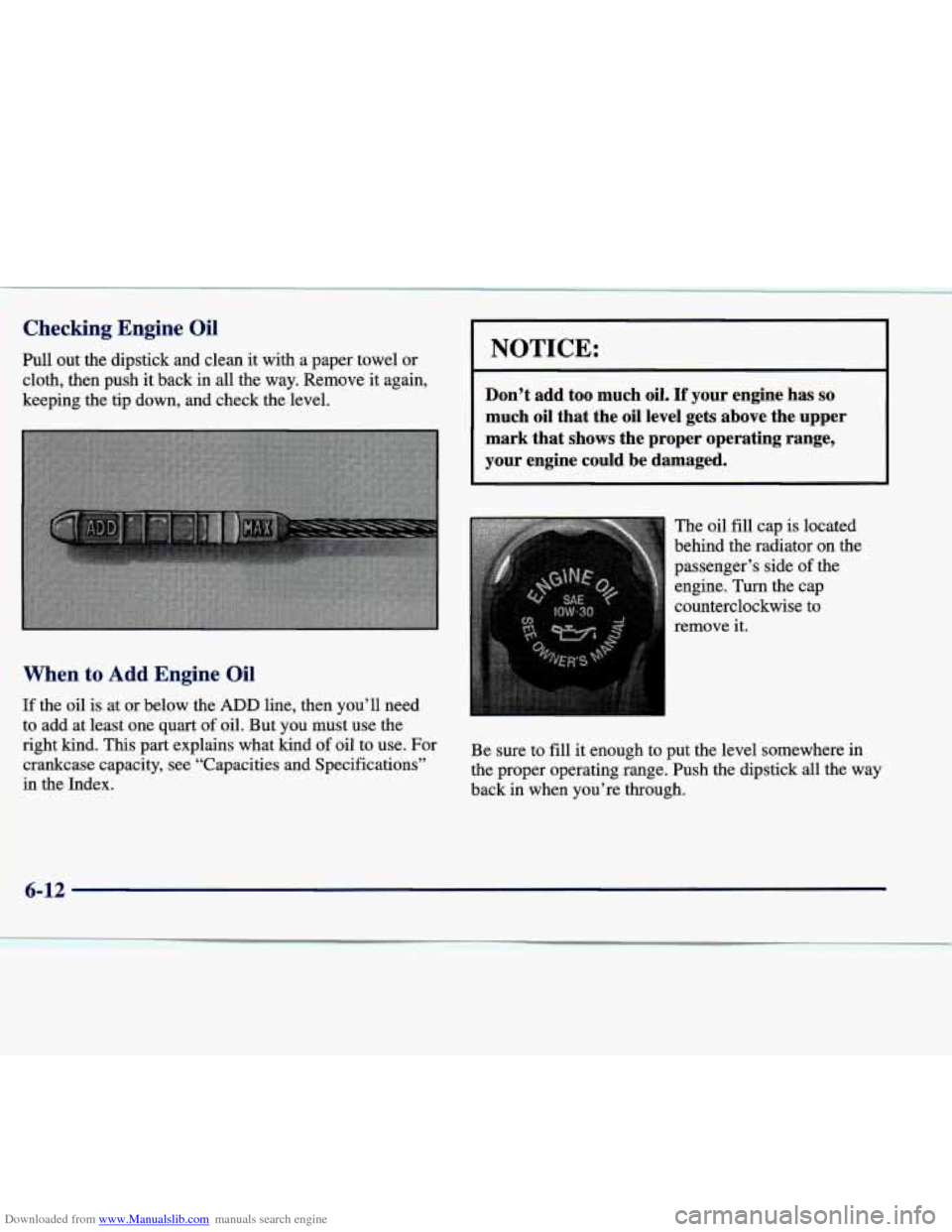
Downloaded from www.Manualslib.com manuals search engine Checking Engine Oil
Pull out the dipstick and clean it with a paper towel or
cloth, then push it back in all the way. Remove it again,
keeping the tip down, and check the level.
When to Add Engine Oil
If the oil is at or below the ADD line, then you’ll need
to add at least one quart
of oil. But you must use the
right kind. This part explains what kind
of oil to use. For
crankcase capacity, see “Capacities and Specifications’’
in the Index.
NOTICE:
Don’t add too much oil. If your engine has so
much oil that the oil level gets above the upper
mark that shows the proper operating range,
your engine could be damaged.
The oil fill cap is located
behind the radiator on the
passenger’s side of the
engine. Turn the cap
counterclockwise to
remove it.
Be sure to fill it enough to put the level somewhere
in
the proper operating range. Push the dipstick all the way
back in when you’re through.
6-12
Page 323 of 378
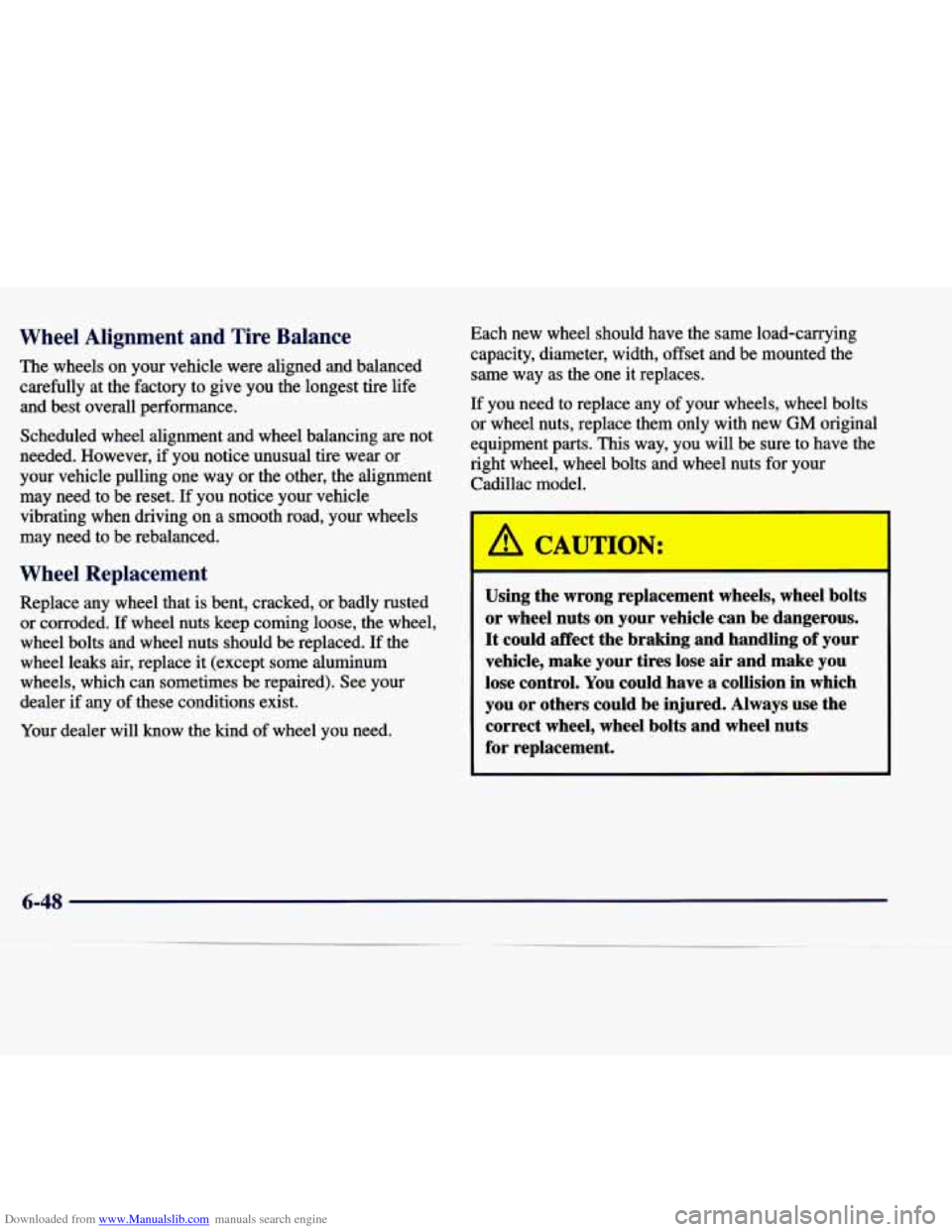
Downloaded from www.Manualslib.com manuals search engine Wheel Alignment and Tire Balance
The wheels on your vehicle were aligned and balanced
carehlly at the factory to give you the longest tire life
and best overall performance.
Scheduled wheel alignment and wheel balancing
are not
needed. However, if
you notice unusual tire wear or
your vehicle pulling one way
or the other, the alignment
may need
to be reset. If you notice your vehicle
vibrating when driving on a smooth road, your wheels
may need to be rebalanced.
Wheel Replacement
Replace any wheel that is bent, cracked, or badly rusted
or corroded. If wheel nuts keep coming loose, the wheel,
wheel bolts and wheel nuts should be replaced. If the
wheel leaks air, replace it (except some aluminum
wheels, which can sometimes be repaired). See your
dealer
if any of these conditions exist.
Your dealer will know the kind of wheel you need. Each new wheel should have the same load-carrying
capacity, diameter, width, offset and be mounted the same way as the one it replaces.
If you need to replace any of your wheels, wheel bolts
or wheel nuts, replace them only with new GM original
equipment
parts. This way, you will be sure to have the
right wheel, wheel bolts and wheel nuts for your
Cadillac model.
Using the wrong replacement wheels, wheel bolts
or wheel
nuts on your vehicle can be dangerous.
It could affect the braking and handling of your
vehicle, make your tires lose air and make you
lose control.
You could have a collision in which
you or others could be injured. Always use the correct wheel, wheel bolts and wheel nuts
for replacement.
6-48